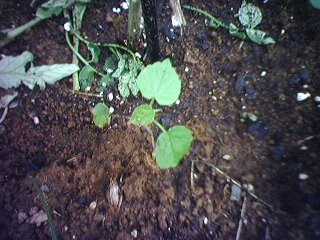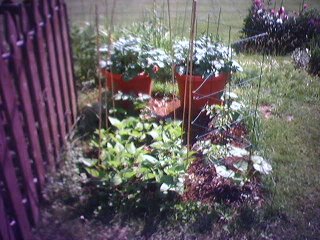
Heavy doses of synthetic pesticides serves to keep pest populations at a minimum. This is good and well except for one, small, side-effect. Pesticides kill not only harmful species but also good ones, in fact, it sterilizes the soil of most plant, insect, and microbiotic species. Pesticides in conjunction with synthetic fertilizers are the foundations of the green revolution. Modern agriculture as we know it depends on these two ingredients. Unfortunately, modern agricultural practices tends transform fertile land into a barren growing medium. After several successive applications of chemical pesticides, the soil becomes almost devoid of life. In effect, pesticides eliminates the natural fertility of soil, making it unproductive without large inputs of chemical fertilizers. Thus the use of pesticides have made modern food production dependent upon continuous application of fossil fuel based fertilizers.
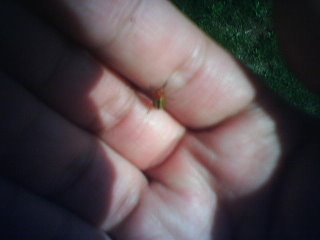
Now under normal conditions, an organic gardener like me would never consider the use of chemical pesticides, but the events of this weekend almost turned me to the dark side. On saturday, I noticed many small holes on one of my potatoe plant's leaves. Upon closer examination, I found that a plague of potatoe bugs was systematically eating my plant. To add insult upon injury, these insects were copulating madly and laying batches of tiny eggs everywhere. Shocked by this discovery, I proceeded to examine the garden under a magnifying glass, and discovered a miniature world.
In biological terms, my garden is very much like an island. A piece of ground had all of it's previous flora removed, as I had done when I pulled out all of the grass and weeds and tilled the soil. Most of the area's fauna were also removed by this process. Lawn grass hosts a series of grass eating insect species such as crickets, fireflies, Mayflies, slugs...etc. Such species cannot venture into my garden due to the lack of food and/or cover. Most insect species within my backyard lawn cannot actually survive in my garden due to the same reasons. But a subset were apparently able to. It appears that a certain ecology had evolved within my garden that is significantly different from that of my lawn. Under the cover of the broad leafed squash and string bean plants at ground level, there were lots of centipedes and earth worms, but no milipedes, since the big leaves and daily watering gave the area under it perpetual shade and moisture-laden soil. Under the container based potatoe plants, the earth worms that I had left with the compost had multiplied, and they were until recently the only fauna in these containers. Under the tomatoe plants, which is at last growing vigorously taller, an ant colony had appeared where there was open soil with no vegetation and perpetual sunlight. Even as I was observing them, a legion of ants were busy hauling a dead centipede back to their colony.
Going upwards from ground level, there were aphids sucking on the stems of my string bean plants. Looking closer, I saw that the aphids were actually being HERDED by ants up and down the stalks of my plants. The ants were tiny, and the aphids were even smaller. I could not kill them for fear of breaking my still growing bean stalks. In my potatoe plants, the stems were largely empty in the healthy ones.
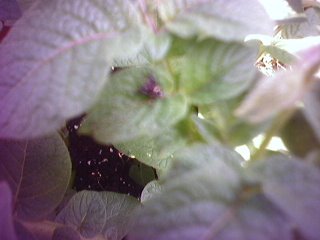
In the one sick potatoe plant, the stems were crawling with potatoe bug hatchlings which were in a gray-camo color, these I proceeded to exterminate whereever they were found. In one section of the plant, I noticed that a small spider was eating a young potatoe bug.
Going higher to the leaf canopy, the sick potatoe plant was in bad shape. There were a score of mature potatoe bugs and they were all doing one of three things: eating, humping, or laying eggs. And they are doing it on my EXPENSE!!! These mature potatoe bugs were quickly dispatched with my fingers and dropped near the ant colony to be recycled. But I knew that there were more hatchlings hiding all over the stem structure of that plant, thus I went through my lawn and found 3 more spiders just like the one I saw on the potatoe plant, these, I placed strategically upon the stem regions of the ailing potatoe plant.
Along the leaf canopy cover of the string beans, there were several "herds" of dozens of aphids each, and they were all happily sucking away on my hard work. The ants were guarding their domestic cattle. But I saw two lady bugs who were happily eating the aphids, the ants were not much use due to them lacking the ability to fly like the ladybugs. Seeing this, I quickly gathered around the lawn and found 6 lady bugs, these I deposited on the leaves of my string bean and squash plants. It was anarchy, aphids were being taken out all over the place.
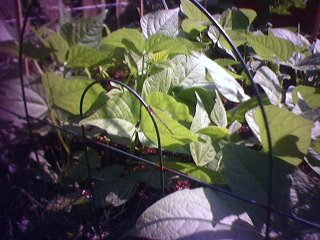
Above the leaf canopy, fruit flies were flittering from flower to flower, gathering precious pollen and nector. And even there, predators roamed. Dragon flies and wasps were having a field day, they were getting their fill of fruit flies. Now from my perspective, fruit flies don't really harm or benefit my garden, since all of my plants are capable of both sexual and asexual reproduction. Thus, I didn't disturb this predator-prey relationship. Now as I was glancing over the unshaded portions of my garden where my tomatoe plants were situated, I noticed that weeds were cropping up at various points. These weeds were competing for nutrients with the tomatoes, and this cannot be allowed. Thus the weeds were entirely removed from that area, and then I covered dead grass/weed clippings around the base of the entire tomatoe plant but not directly under it. I wanted to preserve the ant colony for ants are useful creatures. The clippings ensure that weeds will have no chance of re-emerging due to lack of sunlight. In short, I used the dead weeds to prevent new weeds from growing along the periphery of the tomatoe plants.
